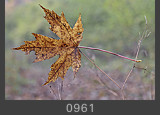 I wrote the following story about this image for two of my grandsons, who were 7 and 9 at the time. I wanted to show them what they can do if they combine several subjects (English, science and art) together, and how, if they look very closely at anything in nature, they'll find that there's a whole story behind it. I wrote the following story about this image for two of my grandsons, who were 7 and 9 at the time. I wanted to show them what they can do if they combine several subjects (English, science and art) together, and how, if they look very closely at anything in nature, they'll find that there's a whole story behind it.
THE MAPLE LEAF
This is a story about a maple leaf.
There is a small body of water called Spring Valley Lake about a half-hour’s drive east of our house. Surrounding the lake is a forest, with many different kinds of trees, such as sycamore, beech, oak, ash and maple. Near the shore of the lake stands a particular maple tree – a grand, old Silver Maple that sprouted from its helicopter seed back before you or your parents or Grandma or I were born.
Last spring, when you boys were in third grade and kindergarten, after the last snows had melted and as ducks, geese and warblers were stopping by the lake to rest and eat on their long migration north; as the sun climbed higher in the sky and sap began to flow beneath the bark; a new, delicate, yellow-green leaf emerged from a bud at the end of a narrow twig at the end of a long branch, high up in the maple, above the robins and thrushes, where the crows hang out and caw boisterously at each other.
As the days grew longer and the leaf grew to its full size, its color darkened to a deep, rich green as it filled with chlorophyll. This would allow the leaf to perform its magic: to combine light from the sun, carbon dioxide from the air, and water and nutrients from the sap and make food for the tree, so that it could be healthy and continue to grow. All summer long, as you traveled and played, the maple leaf basked in the sun, quivered in the rain, and danced in the wind, all the while making food for the tree. And in doing so, it helped us – it cleansed the air and produced oxygen, so that you and I and all other animals could breathe and live.
After you went back to school, the days got shorter and cooler, the sun dropped lower in the sky once again, and we moved into autumn. The flow of sap beneath the bark slowed to a trickle and the chlorophyll faded from the leaf, revealing a rich golden color with maybe a blush of red-orange. Together with thousands of other leaves on the big, old maple – all undergoing the same kinds of changes but each one with its own, unique color and shape – our leaf sang out a brilliant, cheerful song in the sunlight, the last hurrah! of its brief existence.
Moving through late October and into November, the leaf’s color faded to a mottled, golden-brown. Its delicate veins, which had brought sap to the chlorophyll, were more visible than ever, when sunlight penetrated its translucent tissues. Its shape was no longer perfect, as insects had nibbled on it here and there. At long last, with frigid nighttime temperatures and no more sap to nourish it, the bond between the stem of the leaf and the twig weakened, then broke. One day, without warning, the leaf fell gently from the twig toward the ground, where it would decay and enrich the soil below.
But this was not to be. Only a foot from the ground, our leaf’s descent was arrested by the thin, delicate branches of a wildflower whose name I do not know, because it, too, had lost its leaves and blossoms for the season. So there was our leaf, virtually suspended in air, just waiting for me to arrive with my camera, so I could capture its image and share it with you. Thus ends our story, and there the leaf remains today, I believe, unless a fresh breeze has come along and swept it away.
|